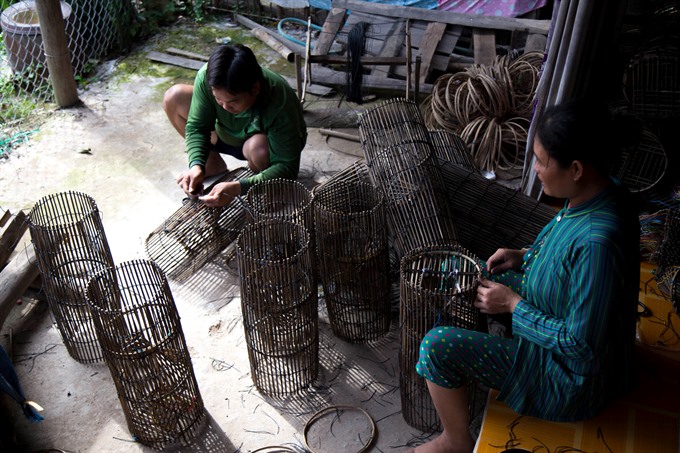 Society
Society

Local people in craft villages that make fishing nets and other tools are now busy serving the needs of fishermen during the annual flooding season.
 |
| Makers of bamboo crab traps in Đồng Tháp Province’s Hồng Ngự Town are now entering the peak season in the Mekong Delta. — VNS Photo |
HCM CITY — Local people in craft villages that make fishing nets and other tools are now busy serving the needs of fishermen during the annual flooding season.
At Mỹ Hòa Village in An Giang Province’s Long Xuyên City, about 600 fish hook makers of more than 100 household producers are now entering their peak season.
Bùi Tấn Thành, owner of Trí Thành enterprise, which makes fish hooks in the city, said the village makes about 10 types of fish hooks in 30 sizes.
“The establishments operate all year, but some of them only work for six months because of the flooding season,” he said.
In Đồng Tháp Province, the peak season has also arrived bamboo crab trap makers in Hồng Ngự Town’s Bình Thạnh Commune.
Phạm Ngọc Thúy, a local bamboo crab traps maker, said that most products were sold in the seventh lunar month each year.
“Households can produce all year and store their products for high demand in the peak season,” she said.
During the flooding season, each household makes at least 500 bamboo traps, and some produce up to 3,000.
Each bamboo crab trap sells for VNĐ25,000 ($1.07), with a profit of VNĐ12,000 ($0.5).
One household can earn a profit of about VNĐ20 million ($856) each season.
Meanwhile, two villages that make fishing nets in Long Hưng B Commune’s Lấp Vò District and Long Hậu Commune’s Lai Vung District are operating at full capacity.
The two villages have a long tradition of providing a large number of products to sell locally and to neighbouring countries Laos and Cambodia.
Establishments in the villages produce year round but the peak season for orders occurs during the flooding season from the seventh to eighth lunar month each year, with demand increasing by about 20 per cent over other months.
They offer diverse products of various sizes popular with fishermen.
Đặng Thị Mơ, owner of the Phúc Lộc fishing net workshop in Long Hậu Commune, employs 20 fishing net makers at her facility and another 30 home-based makers.
Her establishment produces 200 to 300 fishing nets a day that sell for VNĐ60,000-200,000 (US$2.5 -8.5) each, depending on the type and size.
Due to rising costs of labour and raw materials, the price of fishing nets has risen by VNĐ10,000 ($0.4) and VNĐ20,000 ($0.8) each this year, against the same period last year, according to Mơ.
At a craft village that has made boats for a century, located across from the Bà Đài Canal in Lai Vung District, boat makers are busy with a high number of orders this year.
The village is famous for its small fishing boats of different sizes and shapes, but also for large-tonnage ships to sell to locals and the provinces Long An, An Giang, Trà Vinh and Cà Mau.
Nguyễn Văn Thi, a boat maker in the district’s Long Hậu Commune, said the peak season for production is from the beginning of the fourth lunar month to the middle of the tenth lunar month each year.
“I don’t have enough products to meet the high demand right now,” he said.
This year, a boat sells for VNĐ700,000-1.3 million ($30-55), an increase of VNĐ200,000-300,000 ($8.5-13) compared to the same period last year, with a profit of VNĐ80,000-120,000 ($3.4-5.1) each.
Nguyễn Hữu Nghĩa, vice chairman of the Lai Vung District’s People’s Committee, said the villages that make fishing boats and nets are the most famous of the six traditional handicraft villages in the province.
“However, most of them are household-based production and small, and do not use technology, which results in low productivity and low income,” he said.
In the coming time, the district plans to train the labour force, develop tourism products associated with handicraft villages, and mechanise production. It will also promote handicraft products at expos and fairs, according to Nghĩa. — VNS